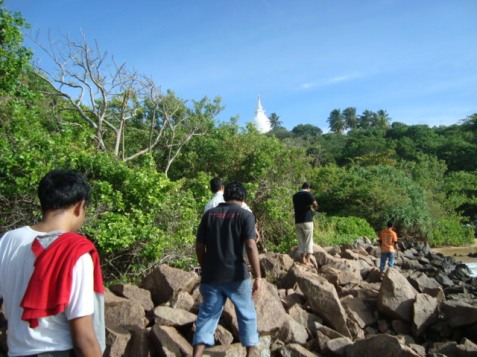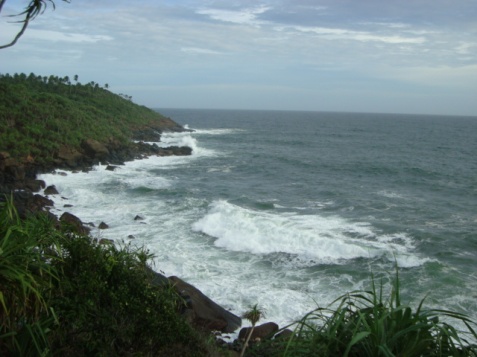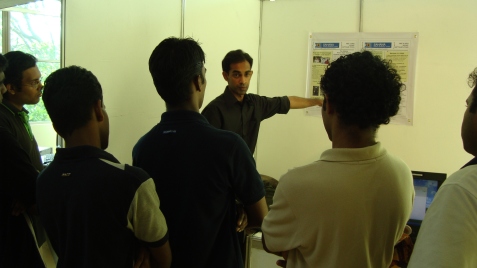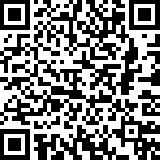Loadstar is a manufacturing organization carrying out its operations based on several plants scattered around Western and Southern parts of Sri Lanka. It was started in 1984 as a joint venture of Jinasena Group of Companies of Sri Lanka and Solideal International of Belgium. Its production is mainly based on rubber, one of the three main export crops of Sri Lanka. It was started as a BOI project and now acts as one of the world’s leading Tyre manufacture in Industrial Tyres.
As an individual entity it contributes to 3% percent of country’s total foreign income and it purchases over 70% of the total rubber production in Sri Lanka. Currently all of its manufacturing requirements are fulfilled by its own chain of companies. It has around 8200 employee base contributing at various stages of its manufacturing effort and they recognized each and every employee as a member of the company. Its main production is aligned under four main product lines:
- Air Tyres
- Solid Tyres
- Rubber Tracks
- Rims & Wheels
Their productions are exported to over 90 countries, distributed among Europe, North & South America and Africa using more than 150 sales centers. The manufacturing is purely handled in Sri Lanka under the authority of Jinasena Group of Companies and the sales are handled by the Solideal International through their sales centers in USA, Canada, Germany, France, Italy, UK, Sweden, Poland, Australia, etc… Their target customer segment is the original equipment manufacturers(OEM’s) in the world(26 altogether), such as Toyota, Nissan, FIAT, TCM, Mitsubushi, Lugli, Atlet, Komatsu, JCB, Simba to name a few.
They maintain nine rubber collecting centers scattered around the country and they have the South Asia’a biggest rubber mixing plant at Kotugoda. It carries out the initial preparation for the collected rubber sheets before releasing them to the plants (at Midigama, Ekala, etc..) to carry out the actual manufacturing of the Tyres. They have a plant called Kiyotho at Ekala equipped with fully automated robotic technology to carry out the manufacturing of the Rims and the Wheels.
At Midigam, Loadstar has one of its main Tyre manufacturing plant that operates 24 hours a day and 365 days a year. According to them the plant stops its normal operations only during Sinhala & Tamil New Year and this April it was for only seven days. The entire facility is equipped with the modern equipments and technologies and most of the mechanical machinery has been designed and built by the engineers in the company to efficiently utilize the energy, materials, workforce and the space. Every production line is properly managed and well looked after. To maintain the quality aspects they have recently introduced the S5 methodology at the facility. Through that they have managed to greatly reduce the cost and increased the productivity by identifying the inefficient processes and excess utilization of human labor. They have achieved several ISO standards, to name them:- ISO:9001:2000 & ISO:14001:2004. All the Loadstar members always try to cultivate and maintains five values among them.
- Make the customer delight
- Respect each other
- Honesty
- Dedication, collective responsibility and ownership
- Respect the values and virtues of culture and environment
We were warmly welcomed by the management at the Midigama plant and given an introduction and insight of the company by the officials at the Human Resource department. Later we were introduced to the engineers at the plant, the brains behind its operations and machinery. Where ever you look you only see is huge machinery carrying out specific task of the tyre manufacturing process. There were Tyres that are so huge even I felt that I’m too short(5′ 10″) compared to them. There were some Tyres that used several dozens of iron bar for a single Tyre other than the use of strips of rubber coated copper wires. For a single Tyre they used several layers of rubber compounds of varying proportions, for me it was a totally new experience because previously I have only heard about it form others but this gave me a chance to experienced it by my own eyes, on how really each activity is taking place at the each stage of the process. They were always experimenting on new ways and methodologies to improve the quality and increase the efficiency of the Tyres, I’m telling this because I even got a chance to see how they experiment on new things at the plant.

In front of Loadstar

At the Training Center

They joined us with lunch
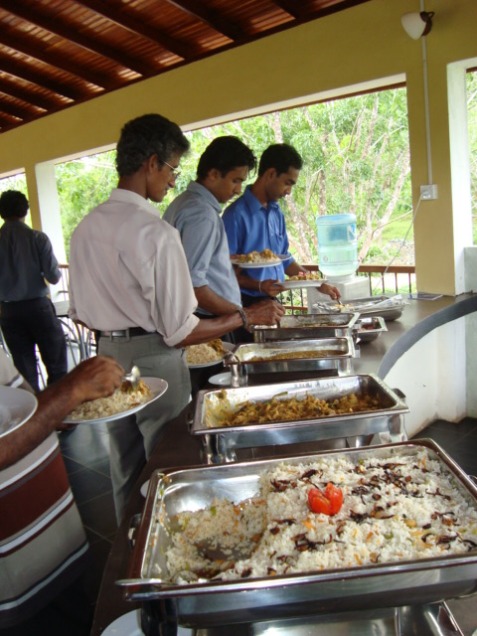
Time for lunch
Unfortunately we were not allowed to take any sort of cameras into the plant. So I did not have the chance to capture some of its memorable moments into pictures, but I’m grateful to the management and everybody at Loadstar for giving us this wonderful opportunity despite their busy schedules. Especially I would like to give my special thank to Dr. J. C. Balasuriya for arranging this field visit to Midigama Loadstar manufacturing plant as a part of our Robotics lectures at the Faculty.
Although it was a field trip, we had an enjoyable time throughout the two days. The quest to Midigama started on Wednesday afternoon, stopped at Galle to have some snacks. Then we decided to visit Rumassala (since it was only few kilometers away), to one of the richest bio-diversed coral sanctuary in the world, but unfortunately it has lost most of its richness due to the Asian Tsunami devastation in 2004. We had an adventurous walk along the beach towards the Temple thanks to Deneth’s love of exploring the natural beauty. Next we head to our resting place. There we met one of our lab assistance, Lalith who was there at the Faculty last year before joining the non-academic staff of University of Ruhuna recently. He took us to a marvelous nearby beach for us to have swim in the sea; it was around 7 o’clock in the night. Although we could hardly see each other I stayed in the sea playing with each other and there was a small island that was there within our reach towards the sea about 100 meters. After the nice sea bath everybody headed to explore the island in the dark. It was picturesque to watch the sea form the top where the sun is setting down and the sea waves splashing against the rock beds scattering water all over. It was next the day we visited Loadstar at Midigama and spend the entire day at the manufacturing plant. While returning back our lecturer invited us to his place for a tea. We reached the lecturer’s place by 7 0’clock and it was a fabulous thing at that moment because everybody is so tired and hungry. We stop at Nadeesha’s place at Ambalangoda for dinner around 10 0’clock and reached our destination by mid-night.



